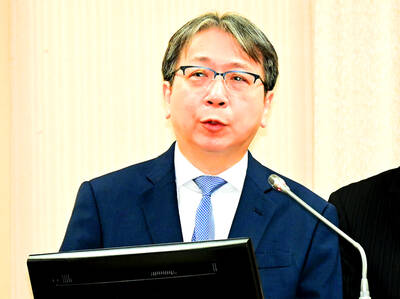President Chen Shui-bian (陳水扁) yesterday visited the families of the four Chiayi construction workers washed away by floodwaters on Saturday and offered his apologies to the bereaved families in person.
Chen told the families that the government was at fault and would take full responsibility, promising the families compensation and to help take care of their livelihoods.
In a statement released on Tuesday, Chen offered an official apology for the government's failure to rescue the workers in time, amid criticism over what was called the government's incompetence.
Premier Tang Fei (
Instead, Vice Premier Yu Shyi-kun, who also headed the Cabinet's disaster prevention and rescue task force, resigned on Tuesday to take the blame.
National Police Administration Director-General Ting Yuan-chin (
Red tape and poor coordination between the air force and police has been blamed for the delayed dispatch of a rescue helicopter.
In addition, local fire-fighters were also blamed for not being able to implement effective measures to help the workers when they needed rescuing.
Continuing their pressure on the government, opposition lawmakers yesterday demanded that Vice Minister of the Interior Lee Yi-yang (
"Many agencies were responsible for the incident, and the fire-fighting and air police forces that were responsible for much of the mismanagement are all under the Ministry of the Interior," said Tseng Yung-chuan (
Both Minister of the Interior Chang Po-ya (
The lawmakers, from the KMT, New Party and People First Party, said that since Chang was abroad when the tragedy took place, Lee should be the one to take political responsibility on behalf of the interior ministry.
In response, Chang said the fatal incident was being "over-politicized" by the opposition parties.

TRAGEDY STRIKES TAIPEI: The suspect died after falling off a building after he threw smoke grenades into Taipei Main Station and went on a killing spree in Zhongshan A 27-year-old suspect allegedly threw smoke grenades in Taipei Main Station and then proceeded to Zhongshan MRT Station in a random killing spree that resulted in the death of the suspect and two other civilians, and seven injured, including one in critical condition, as of press time last night. The suspect, identified as a man surnamed Chang Wen (張文), allegedly began the attack at Taipei Main Station, the Taipei Fire Department said, adding that it received a report at 5:24pm that smoke grenades had been thrown in the station. One man in his 50s was rushed to hospital after a cardiac arrest

SAFETY FIRST: Double the number of police were deployed at the Taipei Marathon, while other cities released plans to bolster public event safety Authorities across Taiwan have stepped up security measures ahead of Christmas and New Year events, following a knife and smoke bomb attack in Taipei on Friday that left four people dead and 11 injured. In a bid to prevent potential copycat incidents, police deployments have been expanded for large gatherings, transport hubs, and other crowded public spaces, according to official statements from police and city authorities. Taipei Mayor Chiang Wan-an (蔣萬安) said the city has “comprehensively raised security readiness” in crowded areas, increased police deployments with armed officers, and intensified patrols during weekends and nighttime hours. For large-scale events, security checkpoints and explosives

PUBLIC SAFETY: The premier said that security would be tightened in transport hubs, while President Lai commended the public for their bravery The government is to deploy more police, including rapid response units, in crowded public areas to ensure a swift response to any threats, President William Lai (賴清德) said yesterday after a knife attack killed three people and injured 11 in Taipei the previous day. Lai made the remarks following a briefing by the National Police Agency on the progress of the investigation, saying that the attack underscored the importance of cooperation in public security between the central and local governments. The attack unfolded in the early evening on Friday around Taipei Main Station’s M7 exit and later near the Taipei MRT’s Zhongshan

ON ALERT: Taiwan’s partners would issue warnings if China attempted to use Interpol to target Taiwanese, and the global body has mechanisms to prevent it, an official said China has stationed two to four people specializing in Taiwan affairs at its embassies in several democratic countries to monitor and harass Taiwanese, actions that the host nations would not tolerate, National Security Bureau (NSB) Director-General Tsai Ming-yen (蔡明彥) said yesterday. Tsai made the comments at a meeting of the legislature’s Foreign Affairs and National Defense Committee, which asked him and Minister of National Defense Wellington Koo (顧立雄) to report on potential conflicts in the Taiwan Strait and military preparedness. Democratic Progressive Party (DPP) Legislator Michelle Lin (林楚茵) expressed concern that Beijing has posted personnel from China’s Taiwan Affairs Office to its